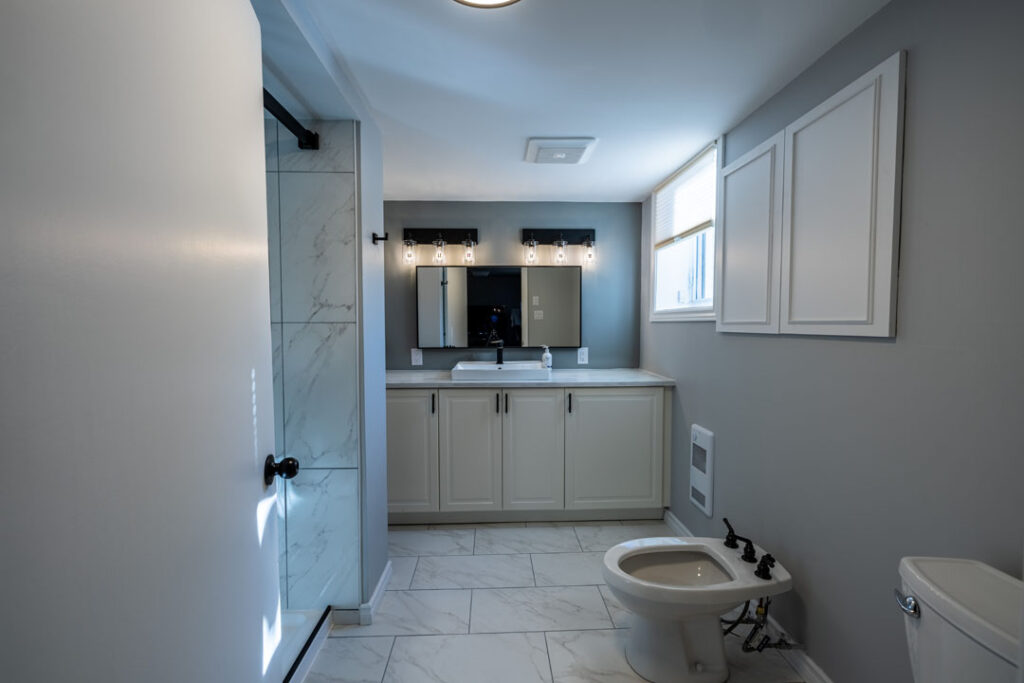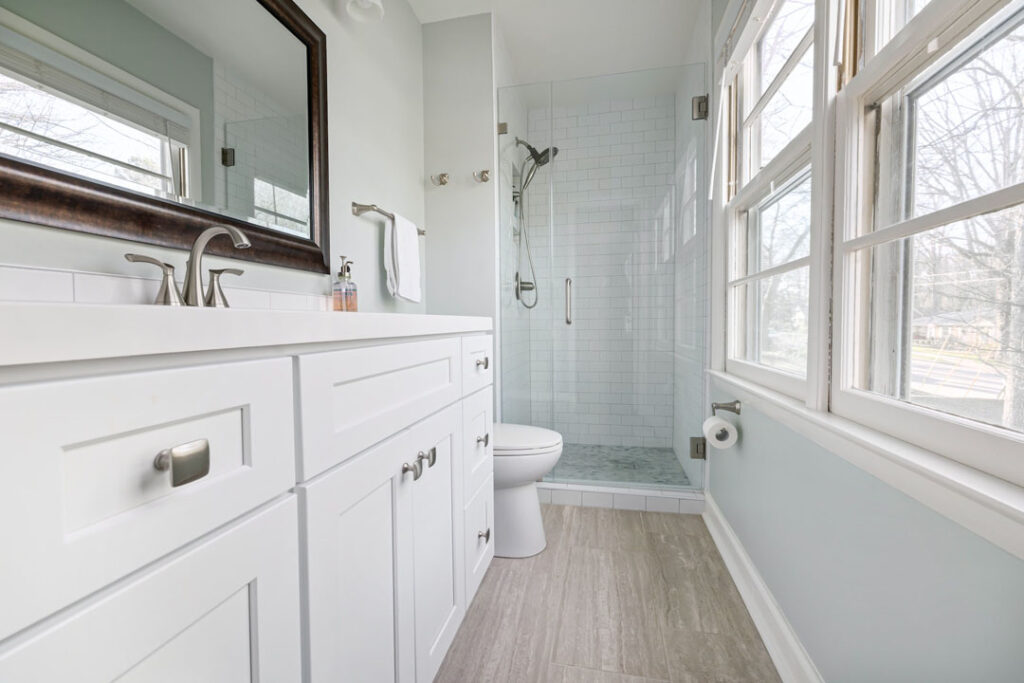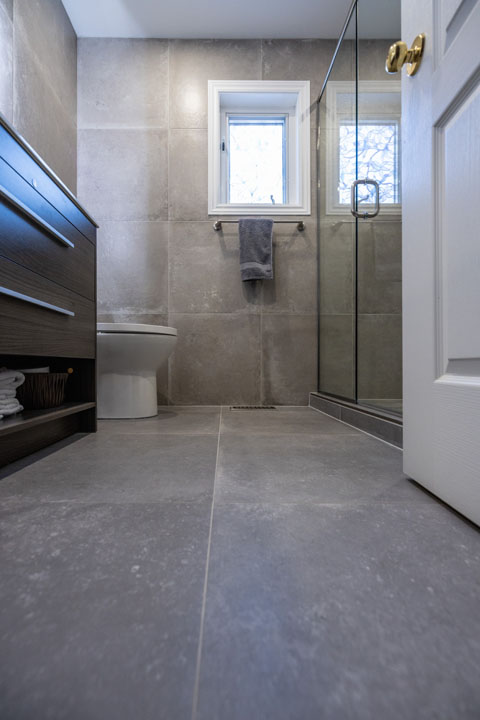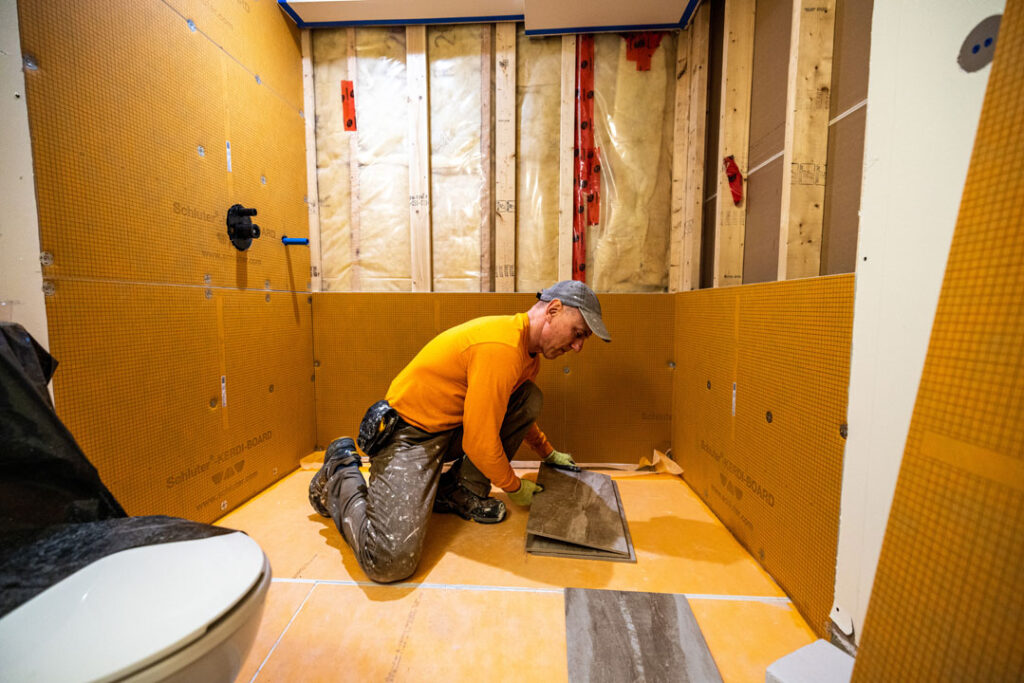With so many bathroom flooring options, finding the right one for your bathroom may feel overwhelming. There are tile, vinyl, wood, laminate, and many other popular bathroom floor options – each with its own pros and cons. So, how do you know which one is the best bathroom flooring for you? While appearance is a top priority, other factors like cost, water resistance, durability, and maintenance requirements are important. Today, many flooring types come with optional features like radiant floor heating that can add comfort and luxury to your bathroom. We’re here to help you examine the different types of bathroom flooring to select the perfect one for your needs. Let’s dive into some of the most common bathroom floor options.
Discover Bathroom Flooring Options

Ceramic and Porcelain Tiles
Porcelain tile is one of the most common flooring options for bathrooms because it is waterproof, affordable, easy to clean, and looks great. Porcelain and ceramic tiles are very similar – porcelain is a type of ceramic tile. The difference between the two is the water absorption rate. Porcelain has a water absorption rate of 0.5 percent or less, making it slightly more favored when it comes to full bathroom flooring. Ceramic tiles are ideal for half baths or powder rooms since they do not contain a shower or bathtub.
There is such variety in the world of ceramic tiles. Some tiles resemble wood or stone and are available in different shapes, sizes, and textures. You can install them as individual tiles or as a sheet. In addition to being slippery. some of the disadvantages are that it feels cold underfoot, but there is a remedy for this. You can install heating under it.
Vinyl flooring
Vinyl flooring has been a popular choice for decades. It comes in sheets, planks or tiles. If you expect to have lots of water spills in your bathroom, as is the case if you have young children, the best option is to install sheet vinyl flooring. The absence of seams in the sheets creates a waterproof barrier on your floor. In recent years, luxury vinyl plank flooring has become widely popular.
Vinyl is easy to install and comes in a variety of styles. If you’re looking for a 100% waterproof bathroom flooring option, vinyl is a top contender!
A disadvantage of vinyl flooring is that it doesn’t have a good ROI. Another drawback is that if there are any uneven areas or imperfections on the subfloor, these will be evident on a vinyl surface.


Natural stone
Natural stone is an excellent choice for bathroom flooring and offers a timeless and classic look. It is a hard material, making it durable, and having natural stone flooring can definitely enhance your bathroom. Some popular stone flooring options are marble, granite, and limestone. Another great thing about stone flooring is that it provides an excellent ROI and is waterproof.
The downside to natural stone flooring is that it is expensive, its hard surface is cold, and it is slippery when wet. Some stones are more porous than others and can be more prone to stains i.e. marble. Installing natural stone requires professionals and is not a DIY project.
Laminate flooring
Laminate flooring can create a picturesque bathroom because it is easy on the eyes and produces a breathtaking finish. Laminate is durable and can be used in bathrooms as long as certain precautions are taken. Because the base of the laminate is wood, the wood in bathroom laminate flooring needs to be protected from moisture and made waterproof. This is done by creating tight seams between the planks. One of the great properties of laminate is that it is easy to clean, inexpensive, easy to install and durable. The drawback of this flooring type is that it cannot be repaired if the wood base is damaged by water.


Engineered Wood Flooring
Engineered wood is a better bathroom flooring option than solid wood. Due to its plywood base, engineered wood fares better in moist environments. It can be designed to look just like wood because the top layer is made of hardwood veneer. Resembling wood is one of the reasons many people love engineered wood. While it does perform better in moist environments, if water is allowed to stay on the floor for some time, the vinyl layer can begin to deteriorate. It is a relatively expensive type of flooring option.
Cork flooring
Cork is a renewable resource made from bark and is gaining popularity as a bathroom flooring option because it resists mould and mildew, and is waterproof. This makes it a great fit for bathrooms. And the fact that it is environmentally friendly is a bonus. Cork can come in tiles that can be glued to the floor to offer a finished or unfinished surface. These are a good option for above-grade bathrooms while cork planks are a better fit for below-grade bathrooms.
Maintaining cork flooring involves re-sealing it every few years. This protects the surface from moisture. To create a waterproof seal, go with unfinished cork and then have it finished during the installation process. Installing cork flooring can be complex so it’s best to have this done by professionals.


Rubber flooring
Rubber flooring is one of the best choices for a slip-free surface. This makes it ideal for bathrooms used by children. Not only is it waterproof, rubber flooring is affordable, easy to keep clean, and durable. It comes in a variety of colours to suit any bathroom decor. You don’t have to worry about rubber becoming cracked or broken so there are no costly repairs involved. It is also very comfortable.
One of the disadvantages of rubber flooring is that it can become stained. While it generally holds up well against most stains, it can become discoloured by strong detergents or cleaning solutions.
Other considerations for bathroom flooring

Underfloor heating compatibility
Most bathroom flooring options are hard and cold, and this can be problematic, particularly during winter. One of the features gaining popularity is heated flooring, which warms up the floor so it is more comfortable to walk on.
If this is something that’s important to you, you’ll want to ensure that the flooring option you are selecting is compatible with underfloor heating.

Noise reduction and soundproofing considerations
With modern spaces becoming smaller and more compact, privacy can be a concern as noise carries more easily to rooms that are in close proximity.
Choosing a flooring type that has noise-reduction properties is a great way to increase privacy.

Budget, aesthetics, and personal style preferences
At the end of the day, the flooring you use in your bathroom should be a good fit in every regard.
It should appeal to your personal style and provide the kind of look you’re going for. In addition, it should fit within your budget.
